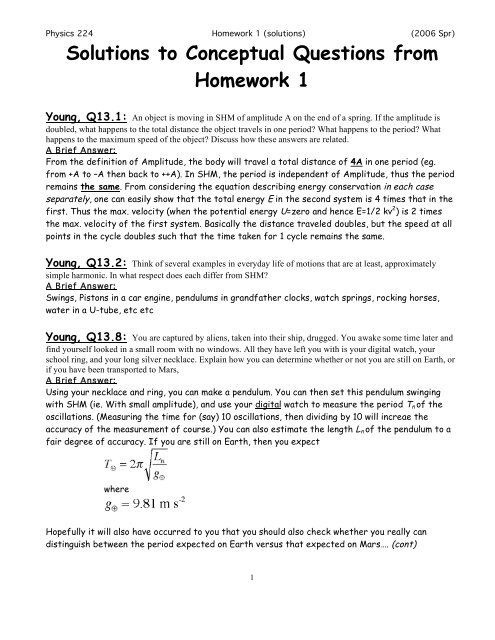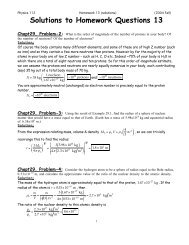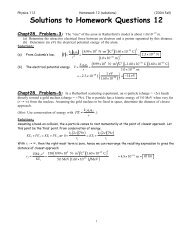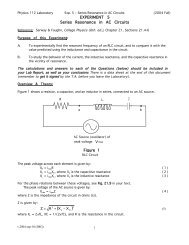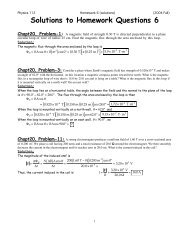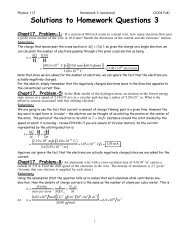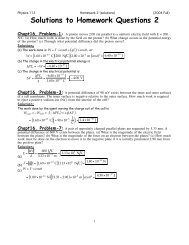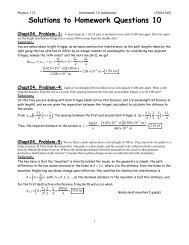Solutions to Conceptual Questions from Homework 1
Solutions to Conceptual Questions from Homework 1
Solutions to Conceptual Questions from Homework 1
Create successful ePaper yourself
Turn your PDF publications into a flip-book with our unique Google optimized e-Paper software.
Physics 224 <strong>Homework</strong> 1 (solutions) (2006 Spr)<br />
<strong>Solutions</strong> <strong>to</strong> <strong>Conceptual</strong> <strong>Questions</strong> <strong>from</strong><br />
<strong>Homework</strong> 1<br />
Young, Q13.1: An object is moving in SHM of amplitude A on the end of a spring. If the amplitude is<br />
doubled, what happens <strong>to</strong> the <strong>to</strong>tal distance the object travels in one period? What happens <strong>to</strong> the period? What<br />
happens <strong>to</strong> the maximum speed of the object? Discuss how these answers are related.<br />
A Brief Answer:<br />
From the definition of Amplitude, the body will travel a <strong>to</strong>tal distance of 4A in one period (eg.<br />
<strong>from</strong> +A <strong>to</strong> –A then back <strong>to</strong> ++A). In SHM, the period is independent of Amplitude, thus the period<br />
remains the same. From considering the equation describing energy conservation in each case<br />
separately, one can easily show that the <strong>to</strong>tal energy E in the second system is 4 times that in the<br />
first. Thus the max. velocity (when the potential energy U=zero and hence E=1/2 kv 2 ) is 2 times<br />
the max. velocity of the first system. Basically the distance traveled doubles, but the speed at all<br />
points in the cycle doubles such that the time taken for 1 cycle remains the same.<br />
Young, Q13.2: Think of several examples in everyday life of motions that are at least, approximately<br />
simple harmonic. In what respect does each differ <strong>from</strong> SHM?<br />
A Brief Answer:<br />
Swings, Pis<strong>to</strong>ns in a car engine, pendulums in grandfather clocks, watch springs, rocking horses,<br />
water in a U-tube, etc etc<br />
Young, Q13.8: You are captured by aliens, taken in<strong>to</strong> their ship, drugged. You awake some time later and<br />
find yourself looked in a small room with no windows. All they have left you with is your digital watch, your<br />
school ring, and your long silver necklace. Explain how you can determine whether or not you are still on Earth, or<br />
if you have been transported <strong>to</strong> Mars,<br />
A Brief Answer:<br />
Using your necklace and ring, you can make a pendulum. You can then set this pendulum swinging<br />
with SHM (ie. With small amplitude), and use your digital watch <strong>to</strong> measure the period T n of the<br />
oscillations. (Measuring the time for (say) 10 oscillations, then dividing by 10 will increae the<br />
accuracy of the measurement of course.) You can also estimate the length L n of the pendulum <strong>to</strong> a<br />
fair degree of accuracy. If you are still on Earth, then you expect<br />
where<br />
Hopefully it will also have occurred <strong>to</strong> you that you should also check whether you really can<br />
distinguish between the period expected on Earth versus that expected on Mars…. (cont)<br />
1
Physics 224 <strong>Homework</strong> 1 (solutions) (2006 Spr)<br />
Where is the PHYSICS behind the situation on Earth and that on Mars? … From the above<br />
equation, surely it can only be in the Gravitation acceleration experienced by the make-shift<br />
pendulum.<br />
What is the PHYSICS behind the Gravitational acceleration? … New<strong>to</strong>ns law of Gravitation, and<br />
that fact that the Mass and Radius of Mars is different <strong>to</strong> those of the Earth.<br />
You should recall that for a body of mass M, and radius R (ie a planet), then the accceleration due<br />
<strong>to</strong> gravity at the surface is<br />
[See Young Sect.12.2 for a review]<br />
Given the mass and radius of Mars, the acceleration on the surface is actually 3.7 m s -2 . Thus it<br />
should be relatively easy <strong>to</strong> measure a deviation between the Period of the necklace pendulum<br />
expected on Earth and that on Mars.<br />
Young, Q13.13: If a pendulum clock is taken <strong>to</strong> a mountain <strong>to</strong>p, does it gain or lose time, assuming it is<br />
correct at lower elevations? Explain your answer.<br />
A Brief Answer:<br />
Again, as in Q13.8, for a pendulum in SHM, the period is given by<br />
where<br />
where the R.H.S. is expressed in terms of the Mass and Radius of the Earth, and the height (h) of<br />
the mountain. Obviously the higher the mountain, the lower the value of the ‘local g’ and hence the<br />
longer the period. Thus the clock will “lose time” (eg. if the period is 1 oscillation (or ‘tick’) per<br />
second at the lower evelation, it will obviously take 60s <strong>to</strong> make 60 ticks. However given its lower<br />
period, after 1 real minute it will have made (slightly) less than 60 ticks at the higher elevation,<br />
and hence will appear <strong>to</strong> run slow.)<br />
2


